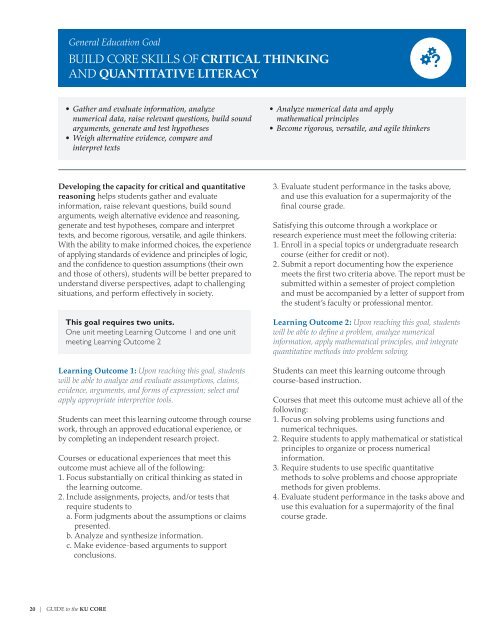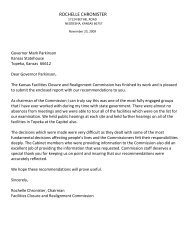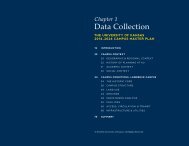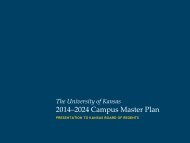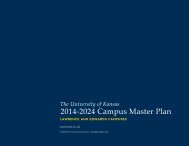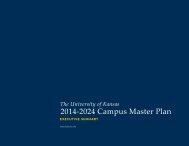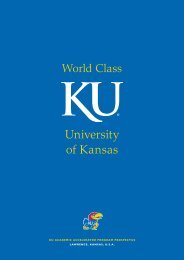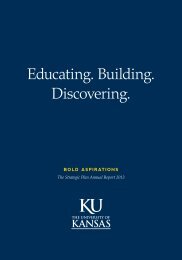Guide to the KU Core
Introduction to KU's first university-wide undergraduate curriculum, prepared for faculty, department chairs, and students.
Introduction to KU's first university-wide undergraduate curriculum, prepared for faculty, department chairs, and students.
You also want an ePaper? Increase the reach of your titles
YUMPU automatically turns print PDFs into web optimized ePapers that Google loves.
General Education Goal<br />
Build core skills of critical thinking<br />
and quantitative literacy<br />
• Ga<strong>the</strong>r and evaluate information, analyze<br />
numerical data, raise relevant questions, build sound<br />
arguments, generate and test hypo<strong>the</strong>ses<br />
• Weigh alternative evidence, compare and<br />
interpret texts<br />
• Analyze numerical data and apply<br />
ma<strong>the</strong>matical principles<br />
• Become rigorous, versatile, and agile thinkers<br />
Developing <strong>the</strong> capacity for critical and quantitative<br />
reasoning helps students ga<strong>the</strong>r and evaluate<br />
information, raise relevant questions, build sound<br />
arguments, weigh alternative evidence and reasoning,<br />
generate and test hypo<strong>the</strong>ses, compare and interpret<br />
texts, and become rigorous, versatile, and agile thinkers.<br />
With <strong>the</strong> ability <strong>to</strong> make informed choices, <strong>the</strong> experience<br />
of applying standards of evidence and principles of logic,<br />
and <strong>the</strong> confidence <strong>to</strong> question assumptions (<strong>the</strong>ir own<br />
and those of o<strong>the</strong>rs), students will be better prepared <strong>to</strong><br />
understand diverse perspectives, adapt <strong>to</strong> challenging<br />
situations, and perform effectively in society.<br />
This goal requires two units.<br />
One unit meeting Learning Outcome 1 and one unit<br />
meeting Learning Outcome 2<br />
Learning Outcome 1: Upon reaching this goal, students<br />
will be able <strong>to</strong> analyze and evaluate assumptions, claims,<br />
evidence, arguments, and forms of expression; select and<br />
apply appropriate interpretive <strong>to</strong>ols.<br />
Students can meet this learning outcome through course<br />
work, through an approved educational experience, or<br />
by completing an independent research project.<br />
Courses or educational experiences that meet this<br />
outcome must achieve all of <strong>the</strong> following:<br />
1. Focus substantially on critical thinking as stated in<br />
<strong>the</strong> learning outcome.<br />
2. Include assignments, projects, and/or tests that<br />
require students <strong>to</strong><br />
a. Form judgments about <strong>the</strong> assumptions or claims<br />
presented.<br />
b. Analyze and syn<strong>the</strong>size information.<br />
c. Make evidence-based arguments <strong>to</strong> support<br />
conclusions.<br />
3. Evaluate student performance in <strong>the</strong> tasks above,<br />
and use this evaluation for a supermajority of <strong>the</strong><br />
final course grade.<br />
Satisfying this outcome through a workplace or<br />
research experience must meet <strong>the</strong> following criteria:<br />
1. Enroll in a special <strong>to</strong>pics or undergraduate research<br />
course (ei<strong>the</strong>r for credit or not).<br />
2. Submit a report documenting how <strong>the</strong> experience<br />
meets <strong>the</strong> first two criteria above. The report must be<br />
submitted within a semester of project completion<br />
and must be accompanied by a letter of support from<br />
<strong>the</strong> student’s faculty or professional men<strong>to</strong>r.<br />
Learning Outcome 2: Upon reaching this goal, students<br />
will be able <strong>to</strong> define a problem, analyze numerical<br />
information, apply ma<strong>the</strong>matical principles, and integrate<br />
quantitative methods in<strong>to</strong> problem solving.<br />
Students can meet this learning outcome through<br />
course-based instruction.<br />
Courses that meet this outcome must achieve all of <strong>the</strong><br />
following:<br />
1. Focus on solving problems using functions and<br />
numerical techniques.<br />
2. Require students <strong>to</strong> apply ma<strong>the</strong>matical or statistical<br />
principles <strong>to</strong> organize or process numerical<br />
information.<br />
3. Require students <strong>to</strong> use specific quantitative<br />
methods <strong>to</strong> solve problems and choose appropriate<br />
methods for given problems.<br />
4. Evaluate student performance in <strong>the</strong> tasks above and<br />
use this evaluation for a supermajority of <strong>the</strong> final<br />
course grade.<br />
20 | GUIDE <strong>to</strong> <strong>the</strong> <strong>KU</strong> <strong>Core</strong>


